North Sea gales, sunshine and Fair Isle landfall! (published November 2016)
What an exciting morning landfall! On May 6, we were located between the Orkney and Shetland Islands, Scotland. Off our bow is a rugged and dramatic island with far more sheep than people and a tiny harbor. Our very excited expedition members spent hours after diesel engine class yesterday researching the extensive bird life and hiking trails and reading about the history of this very isolated island.
In preparation for our 27th expedition season, Amanda and I had spent five weeks aboard Mahina Tiare compared to our normal two weeks because we wanted to give our new engine a thorough sea trial. Also included in our 192,000 mile, 20 year refit was replacing Mahina Tiare’s teak decks, all below-waterline plumbing fixtures, mooring cleats, all ports, hatch lenses and seals.
The weeks before the expedition were spent moored in Hallberg-Rassy’s marina just steps away from where Mahina Tiare was first launched 20 years ago. It was an exciting time as nearly every day another family or group of sailors would arrive to pick up, provision and set sail for home on their new Hallberg-Rassy. We also met folks from Russia, the UK, Ireland, Norway and Sweden who were at the boatyard to test sail new boats and it reminded us of our excitement in 1996 when we were at the Hallberg-Rassy yard ordering Mahina Tiare III, having just returned from sailing to Cape Horn and Antarctica.
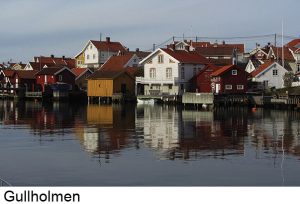 Our Leg 0 (we called it Leg 0 because we added it after all other 2016 expedition legs were filled) crew arrived on Sunday and within an hour we set sail to practice hoisting and reefing sails, ending up at Gullholmen, a picturesque little fishing/holiday island not far from Ellos which is an hour drive north of Gothenburg on Sweden’s NW coast.
Our Leg 0 (we called it Leg 0 because we added it after all other 2016 expedition legs were filled) crew arrived on Sunday and within an hour we set sail to practice hoisting and reefing sails, ending up at Gullholmen, a picturesque little fishing/holiday island not far from Ellos which is an hour drive north of Gothenburg on Sweden’s NW coast.
In 2001 and 2007 when we made this early-season passage we experienced headwinds and rough conditions, getting blown as far up the east coast as Risør. This time we were able to more than lay our course and gained enough southing to sail within 10 miles of Skagen; the northern tip of Denmark.
We requested a passage forecast from Commanders’ Weather before setting sail from Ellos and were amazed at the accuracy, even four days later. Two of our Leg 0 expedition members told us they were looking forward to heavy weather experience and they weren’t disappointed when winds gusted to 32 knots producing short, steep seas that the shallow Skagerrak is known for. We started the passage with two reefs in the main and were down to three reefs before long, with Mahina Tiare still rocketing along at close to eight knots on a close reach. Only two experienced seasickness and once they switched to Stugeron they were over it within an hour.
The crew for this expedition consisted of a mix of seasoned crew and those looking to put more seas miles under their belts. Tim, 54 (and occasionally known as Bob) is originally from the Toronto but now lives near San Francisco were he recently purchased a Catalina 34. Kitty, 59, and David, 58 from Montclair, New Jersey have spent much of their lives sailing dinghies and small boats but were eager to make the jump to larger sailboats and took a few ASA courses prior to this trip. Their next goal is to start looking for a bluewater sailboat of their own. Feather, 57 and her husband Simon, 57, recently moved from Oman to Lund, British Columbia and are members of Bluewater Cruising Association in Vancouver. They are planning to start fulfilling their long-held ambition of sailing their Taswell 43 offshore, starting with a circumnavigation of Vancouver Island this summer.
CRUISING NORWAY
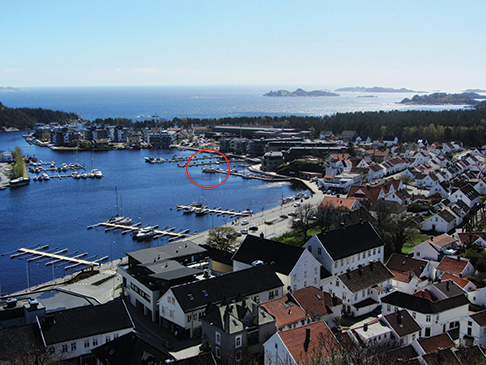
After 0400, the wind and rain started easing and by the time we sighted the coast of Norway the cold front had blown through. The sun was out, the seas were flattening out nicely and we were able to inventory survival packs before landfall at Mandal.
Mandal was still in winter mode— docks were nearly empty, moorage was free and the locals were soaking up the sunshine, telling us it was the sunniest and warmest day of the year. Our keen crew hiked to the town’s viewpoints and enjoyed free showers at the nearby community swimming pool.
We enjoyed a leisurely breakfast aboard before setting sail on our 300 mile North Sea crossing. With sunny and smooth conditions, we rounded Lindesnes, the SW tip of Norway as perfect broad-reaching winds filled in.
Commanders’ had forecasted peak winds of 22 to 30 knots Thursday night and we weren’t disappointed as we had gusts to 34 knots in broad reaching conditions. For the first time this year, the sky never completely darkened in the west before the hints of first light started showing in the east.
Our fast passage meant that we had the rugged outline of Fair Isle on the horizon not long after sunrise Friday morning and by 9:30 a.m. we’d dropped sail, entered North Haven harbor and prepared to moor alongside the pier wall.
Fair Isle’s ferry, the Good Shepherd IV, wasn’t in port but several trucks had been left parked on the pier so we assumed she was on a run up to Shetland. We tied alongside the wharf, but found the surge made it difficult so instead anchored in the kelp and sandy bottom off the wharf in the area recommended on the charts. We had just kind of gotten the anchor to set on our second attempt when a long whistle alerted us to a very unusual and historic looking ship steaming up the narrow channel into the harbor.

Through binoculars we could make out the ship’s name, Stockholm. I recalled reading on Polar Quest’s website that this historic 1953 former Swedish government lighthouse tender was owner-operated as a mini-expedition ship in Spitsbergen, taking only 12 guests. After hailing Stockholm on Channel 16, the owner/captain appreciated our offer to reverse back toward shore as they made the 90 degree turn in relatively shallow water.
Before long Stockholm’s naturalists, guides and guests were ashore and headed up the track. We finished breakfast, launched our RIB and our crew also headed up the hill. After dropping our crew off, I met Per, the owner/captain and Magnus, his relief skipper. They offered us a tour which was like going through a museum. The Swedish-built two-stroke, low RPM engine was original and Per said he had put 40,000 hours on it during the 20 years he had been operating the ship.
When I asked if finding engine parts was a challenge, Per just laughed and said, “I have a spare ship at the shipyard in Gothenburg with an identical engine I use for spares”. The bridge was all original, with walls and roof of teak and the ship’s hold had been turned into the guest dining room with historical black and white photos of Sweden’s king and queen proudly displayed.
After the tour, I had planned to stand anchor watch as there was very little swinging room and I knew the holding ground was not good but with perfect weather I decided to go hiking after letting out more chain and again setting the anchor with the engine in reverse.

Our first hiking stop was after a short walk to Fair Island Bird Observatory and Guesthouse, where friendly staff said we were welcome to join them for drinks or dinner and offered us maps and brochures of the island and their 60-year ongoing research project of logging of migratory bird visits. http://www.fairislebirdobs.co.uk/
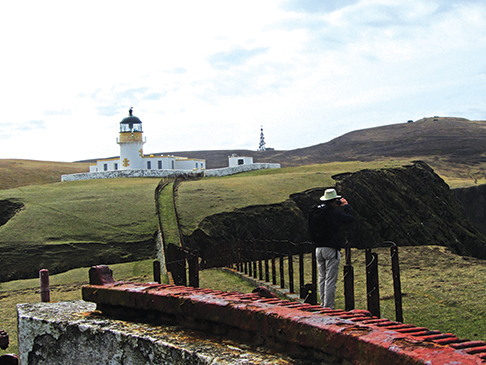
We all walked for hours admiring the birds and lambs, visiting the one tiny shop, the impressive South Lighthouse built by Robert Louis Stevenson’s family and the tiny museum in the former school house.
Returning to North Haven I saw that the wind had done a 180, and that Mahina Tiare’s stern now appeared quite close to rocks astern which had not been visible at high tide when we arrived. It turns out Tim had returned a couple hours earlier and noticed that the wind had changed direction along with a significant drop in tide. Stockholm’s crew gave Tim a ride out to Mahina Tiare then helped him re-anchor. Thank you Tim and Stockholm. I’d best not be so relaxed about tides and possible wind changes in the future!

As soon as the rest of our crew returned they set our second bow anchor, a 44 pound Delta. By slowly motoring forward while letting out chain on the main anchor they were then able to drop the second bow anchor which held well.
MORE EXPLORATION
At the observatory, Amanda had noticed an open invitation for anyone to join the assistant warden on his 7:00 a.m. rounds of the bird traps, and three of our five were ready at 6:30 a.m. for that adventure.
While walking on the road towards the village, we noticed a large brown owl perched on the garden fence post outside the observatory. It watched closely as we walked by and it didn’t seem at all perturbed by our presence. On the daily sighting chalk board in the observatory Amanda read that the sight owl was oiled. When asked about this, Ciaran said the owl probably landed on a cliff and disturbed the nesting fulmars. Fulmars defense mechanism is to vomit the oily contents of their stomachs onto their predators. This oiling had decreased the waterproofness of the owl’s feathers and often they don’t survive. The owl has been waiting a month for the oil to dissipate so it can continue its migration.
Getting Mahina Tiare safely out of the small harbor that had become a lee shore required close teamwork. First the crew pulled and stowed the secondary anchor before raising the main anchor then it was a quick hoisting of the mainsail before we left the shelter of the isle’s cliffs.
We then set off on a grand and breezy 24 mile broad reach to North Ronaldsay, the northernmost island in the Orkney group. We found an open bay on the southern side of the island that provided some protection for the forecasted near-gale ESE winds and Amanda taught both sail design and sail trim classes as the breeze built over the evening. We’d looked forward to checking out the unique ancient breed of seaweed-eating sheep ashore, but with a choppy dinghy ride, low tide and no simple landing places we decided to wimp out and stay aboard. Hopefully we’ll be able to check out the strange sheep on Leg 1 as we sail to Shetland.
Sunday morning was misty, foggy and still windy so our entire crew assisted navigator of the day Tim in scouring the charts for an anchorage or harbor that would provide shelter in the forecasted near-gale easterly winds. They chose Pierowall Pier on Westray Island, 20 miles nearly directly downwind. So we wouldn’t have to continually jibe the main as we dodged shallow banks and headlands, we sailed the entire way under headsail alone, which gave us six to seven and a half knots of boat speed without any concerns of accidental jibes. With a three to four meter tidal range we had currents of up to four knots against us and two knots with us at times.
Just before we arrived at Pierowall, (www.orkneyharbours.com) we tried calling the harbormaster. It took several calls on different VHF channels, but Orkney Vessel Traffic System answered on Chanel 11 and offered to ring the harbormaster on his mobile phone. We were pleasantly surprised when he called us back saying, “Portside-to, just inside the sailboat, Happy Swiss III”.
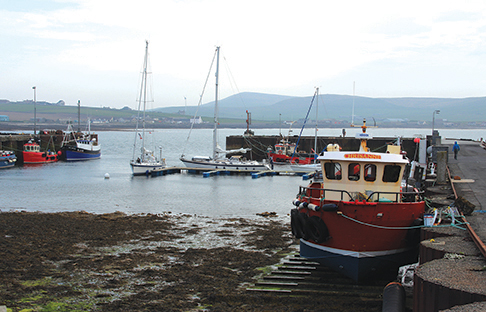
Turns out that piermaster Tom Grendall had asked a 50 foot crab boat to move off the visitors’ pier and onto the outer harbor wall in order to clear a berth for us and was on the dock to welcome us and take our lines. Tom had just retired after 49 years as the captain of the 45 foot ferry that serves Papa Westray, population 60, a small island a few miles away and was very keen to give us the scoop on the village he’d been born and spent his entire life in. Pierowall has a thriving crab and lobster fishery plus a busy processing facility where Tom said we could purchase fresh crab or lobster Monday morning. He also proudly told us about the bakery next door to his home, the abandoned 16th century castle a short walk away, the town’s two shops, hotel/pub/restaurant, museum and the free showers and electricity. What more could a visiting sailor ask for?
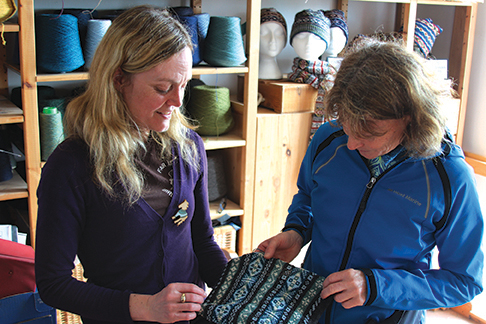 Actually, it got even better! The winds dropped so we all took off exploring. Amanda discovered Hume Sweet Hume; a knit shop run by two very creative and energetic sisters, the castle was very interesting, if a bit bizarre and our crew made reservations at Pierowall Hotel for Sunday Curry Night, with the rest of the village, which was a lot of fun. We also enjoyed visiting with the neighboring crew of Smiling Swiss III, a Hallberg-Rassy 43, one of several yachts owned by The Cruising Club of Switzerland with 7000 members. The club has been going strong for years and members sign up in September for 10 day sailing trips the following summer. The crew we met were sailing the boat from Orkney to Shetland Islands, and the next crew would sail on to the Faroes and Iceland!
Actually, it got even better! The winds dropped so we all took off exploring. Amanda discovered Hume Sweet Hume; a knit shop run by two very creative and energetic sisters, the castle was very interesting, if a bit bizarre and our crew made reservations at Pierowall Hotel for Sunday Curry Night, with the rest of the village, which was a lot of fun. We also enjoyed visiting with the neighboring crew of Smiling Swiss III, a Hallberg-Rassy 43, one of several yachts owned by The Cruising Club of Switzerland with 7000 members. The club has been going strong for years and members sign up in September for 10 day sailing trips the following summer. The crew we met were sailing the boat from Orkney to Shetland Islands, and the next crew would sail on to the Faroes and Iceland!
It was our warmest day yet, with no need for the cabin furnace and everyone was enjoying the sailing to Shapinsay in smooth waters so much that they decided to practice short tacking, just because they didn’t want to stop sailing yet!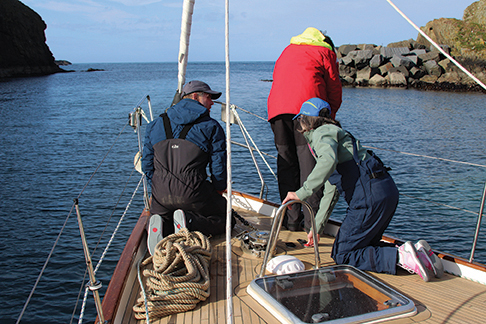
Once anchored, Amanda pulled out our Sailrite sewing machine for a sail repair demo and then taught splicing before I taught storm avoidance and survival tactics. To cover our teaching topics in 10 days versus 14 to 21 days requires dedication on the part of our crew, but everyone on Leg 0 was totally committed to learning everything possible and even asked if we could complete engine room orientation before dinner. On inspecting the engine, I discovered a bolt sticking out of the alternator mount further than it should.
Amazingly the nut had just fallen an inch and was sitting under the alternator. After the the bolt was pushed back in, I applied Loctite thread locker then we tightened it as well as the hinge-mount bolt that was also a slightly loose. This has been our only issue to date with the new engine.
Meanwhile Kitty and Dave volunteered to crack the crab claws on the aft deck with our hammer and they made a tasty addition to our shrimp stir-fry. The morning was warm, clear, and totally calm, so Amanda called for rig inspection aloft before breakfast.
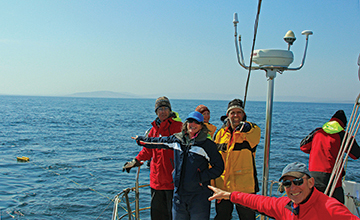 I followed rig inspection with cruising medicine, clearing customs worldwide and long-range cruising communication options before we got underway for Kirkwall. It was a clear and nearly windless day so we had a quiet motor for the dozen or so mile passage.
I followed rig inspection with cruising medicine, clearing customs worldwide and long-range cruising communication options before we got underway for Kirkwall. It was a clear and nearly windless day so we had a quiet motor for the dozen or so mile passage.
On May 11, we moored in Kirkwall Marina, Orkney, Scotland. Once we arrived our industrious crew gave Mahina Tiare a thorough soaping down and clean without being asked to. After exploring the busy little town, they chose the the historic Kirkwall Hotel for our farewell dinner and we were all delighted with the exceptional food.
Overall, it’s been an exceptional expedition with better weather than we ever hoped for, fast passages, fascinating islands and people and one of our best groups in memory.
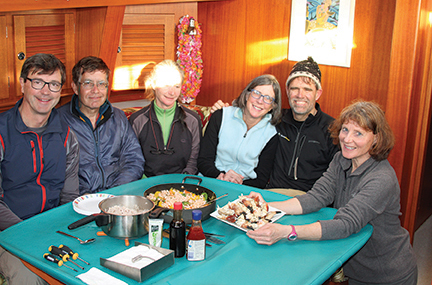
John Neal’s many offshore miles include six Cape Horn roundings plus voyages to Antarctica and Spitsbergen. Since 1976, John’s passion has been sharing his knowledge of ocean cruising and he has conducted more than 170 sail-training expeditions worldwide aboard Mahina Tiare III, a Hallberg-Rassy 46.
Weather:
Commanders Weather: professional weather routing for the very modest fee of US$73 for a 5-7 day forecast
YR.NO: NRK Met Institute—Norwegian government weather site which we think must use the EC forecast model. Incredibly accurate and helpful!
windytv.com: Worldwide GRIB forecast charts utilizing US GFS computer model.
Cruising Guides:
Norwegian Cruising Guide, 7th edition, covering west coast of Sweden and Norway as far north as Kristiansund, Phyllis Nickel & John Harries, Attainable Adventure Cruising, Ltd.
Norway—RCC Pilotage Foundation, Judy Lomax, 2nd edition.
Ports Handbook for Orkney, 6th edition
The Scottish Islands, Hamish Haswell-Smith. 518 pages covering every Scottish island in detail.
Charts:
British Admiralty: 1402, 2182C, 3299, 1954, 2249
Norwegian: 10
Imray: C68
Electronic Charts:
Navionics running on Raymarine MFD
C-Map running on Rose Point Coastal Explorer















